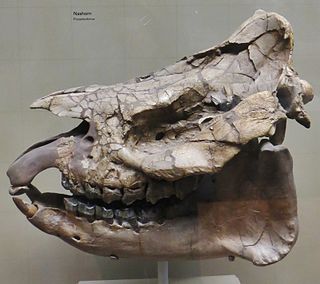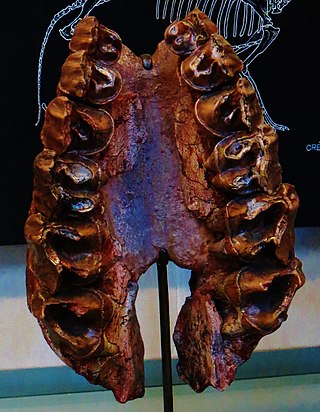
A rhinoceros, commonly abbreviated to rhino, is a member of any of the five extant species of odd-toed ungulates (perissodactyls) in the family Rhinocerotidae; it can also refer to a member of any of the extinct species of the superfamily Rhinocerotoidea. Two of the extant species are native to Africa, and three to South and Southeast Asia.

Teleoceras is an extinct genus of rhinocerotid. It lived in North America during the Miocene and Pliocene epochs during the Hemingfordian to the end of Hemphillian from around 17.5 to 4.9 million years ago. It grew up to lengths of 13 feet long.

Prosantorhinus is an extinct genus of rhinocerotid that lived during the Early and Middle Miocene subepochs. The small teleoceratine rhinocerotid was found in Western Europe and Asia.

Prolagus is an extinct genus of lagomorph. Over 20 species have been named, and the genus was abundant and widespread in Europe during the Neogene. However, by the end of the Middle Pleistocene, it was confined to a single species, the Sardinian pika, on the Corsica, Sardinia, and surrounding islands, where it survived into historical times. In North Africa and Western Asia, the genus is known from the Miocene and Pliocene. The scientific name may mean "before hares" or "primitive hares". Its taxonomy is disputed, with it either being considered a member of the family Ochotonidae, which includes living pikas, or the only member of the family Prolagidae.

Chilotherium is an extinct genus of rhinocerotids endemic to Eurasia during the Miocene through Pliocene living for 13.7—3.4 mya, existing for approximately 10.3 million years.

Dapalis is an extinct genus of prehistoric glassfish known from the Late Cretaceous to the Early Miocene. It is known from both freshwater and marine habitats of India, Australia, New Zealand, and much of mainland Europe.

Hispanotherium is an extinct genus of rhinocerotid of the tribe Elasmotheriini endemic to Europe and Asia during the Miocene living from 16—7.25 mya existing for approximately 8.75 million years.

Aceratheriinae is an extinct subfamily of rhinoceros endemic to Asia, Africa, Europe, and North America, from the Oligocene through the Pliocene. It lived from 33.9 to 3.4 mya, existing for approximately 30.5 million years.

Ceratotherium neumayri is a fossil species of rhinoceros from the Late Miocene (Vallesian-Turolian) of the Balkans and Western Asia, with remains known from Greece, Bulgaria, Iran, and Anatolia in Turkey.

Aceratherium is an extinct genus of rhinocerotid of the subfamily Aceratheriinae that lived in Eurasia during the Miocene.

Aphelops is an extinct genus of hornless rhinocerotids endemic to North America. It lived from the Middle Miocene to the early Pliocene, during which it was a common component of North American mammalian faunas along with Teleoceras.

Plesiaceratherium is an extinct genus of rhinocerotids. It includes two species: P. gracile from China and P. mirallesi from France.

Brachypotherium is an extinct genus of rhinocerotid that lived in Eurasia and Africa during the Miocene.

Diaceratherium is an extinct genus of rhinocerotid from the Oligocene and Miocene of Eurasia.
This paleomammalogy list records new fossil mammal taxa that were described during the year 2013, as well as notes other significant paleomammalogy discoveries and events which occurred during that year.

Shansirhinus is an extinct genus of rhinocerotid endemic to China during the Miocene through Pliocene.
This paleomammalogy list records new fossil mammal taxa that were described during the year 2009, as well as notes other significant paleomammalogy discoveries and events which occurred during that year.

Ronzotherium is an extinct genus of perissodactyl mammal from the family Rhinocerotidae. The name derives from the hill of 'Ronzon', the French locality near Le Puy-en-Velay at which it was first discovered, and the Greek suffix 'therium' meaning 'beast'. At present 5 species have been identified from several localities in Europe and Asia, spanning the Late Eocene to Upper Oligocene.
Pelargopappus is an extinct genus of raptor related to the secretarybird that lived in early Miocene France. Only one species, the type species P. magnus is officially recognized. A second species, P. schlosseri from the mid-and late Oligocene, was split off into the genus Amphisagittarius.

Epiaceratherium is an extinct genus of rhinocerotid from the Eocene and Oligocene of Europe, Asia, and North America.















